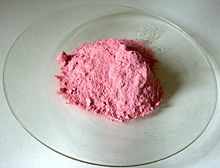Cobalt(II) acetate
Appearance

| |
| Names | |
|---|---|
| IUPAC name
Cobalt(II) acetate
| |
| Identifiers | |
| ECHA InfoCard | 100.000.687 |
CompTox Dashboard (EPA)
|
|
| Properties | |
| C4H6CoO4 | |
| Molar mass | 177.021 g·mol−1 |
| Appearance | Red solid |
| Density | 1.71 g/cm3 (tetrahydrate) |
| Soluble | |
| Hazards | |
| NFPA 704 (fire diamond) | |
Except where otherwise noted, data are given for materials in their standard state (at 25 °C [77 °F], 100 kPa).
| |
Cobalt(II) acetate is the cobalt(II) salt of acetic acid. It may also be found as the tetrahydrate.
It may be formed by the reaction between cobalt oxide or hydroxide and acetic acid:
- CoO + 2 HC2H3O2 → Co(C2H3O2)2 + H2O
Cobalt(II) acetate may be reacted with salenH2 to give salcomine, an oxygen-transport compound:[1]
- Co(OAc) + salenH2 → Co(salen) + 2 HOAc
References
- ^ Appleton, T. G. (1977). "Oxygen Uptake by a Cobalt(II) Complex". J. Chem. Ed. 54 (7): 443.

